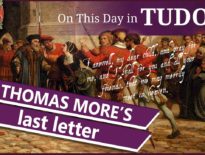On this day in Tudor history, Tuesday 6th July 1535, Henry VIII’s former friend and Lord Chancellor, Sir Thomas More, was beheaded on Tower Hill as a traitor.
In today's talk, I share accounts of his execution, including one that gives real insight into More's personality, with his black humour on the scaffold.
I also give details on the fate of Sir Thomas More's head and what his daughter, Margaret Roper, did with it.
Also on this day in Tudor history, 6th July 1553, fifteen-year-old King Edward VI died at Greenwich Palace leaving the throne to his cousin's eldest daughter, Lady Jane Grey. Find out more about Edward's final illness and last days, his “Devise for the Succession”, and Lady Jane Grey's reaction at being told that she was Edward’s successor, in my video from last year:
Also on this day in history:
- 1537 – Execution of Sir Robert Constable at Beverley's Gate in Hull. Constable had been an active participant in the Pilgrimage of Grace Rebellion in 1536, but had received a royal pardon and had gone on to try and suppress Bigod's Revolt in 1537. However, he was summoned to London in 1537, and subsequently tried and condemned to death. He was hanged in chains.
- 1560 – Signing of Treaty of Edinburgh (Treaty of Leith) between representatives of Elizabeth I and Francis II of France, husband of Mary, Queen of Scots. The terms were that French and English troops were to withdraw from Scotland and that Francis and Mary should stop using the title and arms of the monarch of England and Ireland, which belonged to Elizabeth I.
- 1570 – Death of Margaret Clement (née Giggs), wife of John Clement and adopted daughter of Sir Thomas More, in Mechelen where she and her husband had gone into exile. Margaret was buried in the Cathedral of St Rumbald. Trivia: In 1537, Margaret bribed the gaoler at Newgate Prison to let her feed the Carthusian priests who were starving there.
- 1583 – Death of Edmund Grindal, Elizabeth I's Archbishop of York and of Canterbury, at Croydon.
- 1585 – Executions of Thomas Alfield, Catholic priest, and Thomas Webley, a dyer, at Tyburn. They had been tried and condemned under statute 23 Eliz. c.2 s.2, which made the publication of any book attacking the queen a felony punishable by death. The book in question was Dr William Allen's book, “Modest Defence of the English Catholiques”, which Alfield and Webley had helped to distribute.
- 1614 – Death of Sir Anthony Cope, 1st Baronet, politician and Puritan. He was buried at Hanwell, Oxfordshire.
1618 – Death of John Davies of Hereford, poet and writing master. He was buried in the church of St Dunstan-in-the-West, London. His works included “The Scourge of Folly”, “Writing Schoolmaster”, or, “The Anatomy of Fair Writing” and “Mirum in modum: a Glimpse of Gods Glorie and the Soules Shape”.
Transcript:
On this day in Tudor history, Tuesday 6th July 1535, Henry VIII’s former friend and Lord Chancellor, Sir Thomas More, was beheaded on Tower Hill as a traitor. As I’ve mentioned before, More HAD once said of Henry VIII “if my head would win him a castle in France, it should not fail to go”, and go, it did!
More had been found guilty of high treason under the Treason Act of 1534 for denying the king’s supremacy and refusing to take the Oath of Succession. The punishment for high treason was of course death, and he was lucky that his sentence was commuted from being hanged, drawn and quartered, to beheading.
Chronicler Charles Wriothesley recorded his death as follows:
“This year also, the first day of July, being Thursday, Sir Thomas More, knight, sometime Chancellor of England, was arraigned at Westminster for high treason and there condemned, and the Tuesday after, being the 6th of July, he was beheaded at the Tower Hill, and his body was buried within the chappel in the Tower of London, and his head was set on London Bridge. The effect of his death was for the same cause that the Bishop of Rochester died for.”
Chronicler Edward Hall wrote:
“Also the vi. day of July was Sir Thomas More beheaded for the like treason before rehearsed, which as you have heard was for the denying of the king’s Majesty’s supremacy. This man was also counted learnèd, & as you have heard before he was lord Chancelor of England, and in that time a great persecutor of such as detested the supremacy of the bishop of Rome, which he himself so highly favored that he stood to it till he was brought to the Scaffold on the Tower hill where on a block his head was stricken from his shoulders and had no more harm.
I cannot tell whether I should call him a foolish wiseman, or a wisefoolishman, for undoubtedly he beside his learning, had a great wit, but it was so mingled with taunting and mocking, that it seemed to them that best knew him, that he thought nothing to be well spoken except he had ministered some mock in the communication insomuch as at his coming to the Tower, one of the officers demanded his upper garment for his fee, meaning his gown, and he answered, he should have it, and took him his cap, saying it was the uppermost garment that he had. Like-wise, even going to his death at the Tower gate, a poor woman called unto him and besought him to declare that he had certain evidences of hers in the time that he was in office (which after he was apprehended she could not come by) and that he would entreat she might have them again, or else she was undone. He answered, good woman have patience a little while, for the king is so good unto me that even within this half hour he will discharge me of all businesses, and help thee himself. Also when he went up the stair on the Scaffold, he desired one of the Sheriff’s officers to give him his hand to help him up, and said, when I come down again, let me shift for my self aswell as I can. Also the hangman kneeled down to him asking him forgiveness of his death (as the manner is) to whom he said I forgive thee, but I promise thee that thou shalt never have honesty of the striking of my head, my neck is so short. Also even when he should lay down his head on the block, he having a great grey beard, striked out his beard and said to the hangman, I pray you let me lay my beard over the block lest ye should cut it, thus with a mock he ended his life.”
A document in Letters and Papers gives the following information about More after his trial and about his execution:
“On his way to the Tower one of his daughters, named Margaret, pushed through the archers and guards, and held him in her embrace some time without being able to speak. Afterwards More, asking leave of the archers, bade her have patience, for it was God’s will, and she had long known the secret of his heart. After going 10 or 12 steps she returned and embraced him again, to which he said nothing, except to bid her pray to God for his soul; and this without tears or change of colour. On the Tuesday following he was beheaded in the open space in front of the Tower. A little before his death he asked those present to pray to God for him and he would do the same for them [in the other world.] He then besought them earnestly to pray to God to give the King good counsel, protesting that he died his faithful servant, but God’s first.
Such was the miserable end of More, who was formerly in great reputation, and much loved by the King, his master, and regarded by all as a good man, even to his death.”
As Wriothesley says, his body was buried at the Chapel of St Peter ad Vincula, at the Tower of London, and his head put on a spike on London Bridge. Heads would eventually be thrown into the River Thames, but More’s wasn’t. E E Reynolds, in the book Margaret Roper: Eldest Daughter of St Thomas More, quotes Thomas Stapleton, an early biographer of Thomas More:
“[The head] by order of the king, was placed upon a stake on London Bridge, where it remained for nearly a month, until it had to be taken down to make room for other heads … The head would have been thrown into the river had not Margaret Roper, who had been watching carefully and waiting for the opportunity, bribed the executioner, whose office it was to remove the heads, and obtained possession of the sacred relic. There was no possibility of mistake, for she, with the help of others, had kept careful watch, and, moreover, there were signs so certain that anyone who had known him in life would have been able now to identify the head.”
Reynolds then explains:
“After the death of Margaret Roper, the head was in the keeping of her eldest daughter, Elizabeth, Lady Bray, and it was probably at her death in 1558 that it was placed in the Roper vault under the Chapel of St. Nicholas in St. Dunstan’s, Canterbury.
It was seen there in 1835 when, by accident, the roof of the vault was broken; the head was enclosed in a leaden case with one side open; this stood in a niche protected by an iron grille. The vault was later sealed, but a tablet in the floor above bears the inscription:
Beneath this floor is the vault of the Roper family in which is interred the head of Sir Thomas More of illustrious memory, sometime Lord Chancellor of England, beheaded on Tower hill 6th July 1535. Ecclesia Anglicana libera sit.”
In an article “The scull [sic] of Sir Thomas More”, in The Gentleman’s Magazine of May 1837, there is the following quote about More’s head being seen in the vault in the 18th century, along with the drawing of the skull which you see at the top of this article: “Dr. [then Mr.] Rawlinson informed Hearne, that when the vault was opened in 1715, to enter into one of the Roper’s family, the box was seen enclosed in an iron grate.”
I assume it’s still there.



Leave a Reply